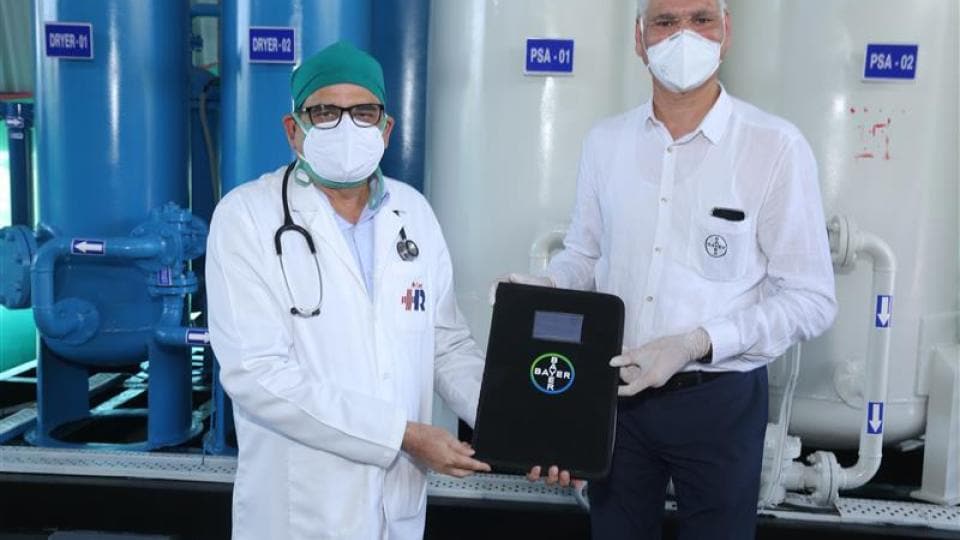Does COVID-19 Cause Thrombosis and Pulmonary Embolisms?

Patients seriously ill with COVID-19 are more susceptible to blood clots, medical experts report. These can clog vital blood vessels in the lungs, for example. What does this mean for patients? We discussed these findings with thrombosis expert Dr. Frank Misselwitz.
Dr. Misselwitz, there are indications that patients with COVID-19 are susceptible to blood clots, which can lead to embolisms or, in layman’s terms, the obstruction of the blood vessels. What is your perspective on these new findings?
During the acute infection phase – particularly the first few weeks – doctors and professors who we’ve collaborated with for many years would call me every day, reporting cases of thrombosis or pulmonary embolisms in their COVID-19 patients. Initially, no one suspected there was a link, as everyone assumed the coronavirus was a pulmonary virus that attacks the lungs and causes serious respiratory infections.
More evidence has come to light since then, however. A Dutch publication analyzing data from 184 patients found thrombosis in a third of people infected with COVID-19. This is much higher than the usual rate of cases in patients with bacterial pneumonia, for example.
Are viral diseases known to be a potential cause of thrombosis?
We can’t say that is generally the case. There are viruses that do just the opposite, causing patients to hemorrhage. Most viral diseases have no effect on thrombosis.
What exactly does the coronavirus do to the body?
We don’t know for sure yet. However, generally speaking, we can now say that COVID-19 seriously damages the inner walls of the blood vessels, known as the endothelial cells. This goes hand in hand with a severe inflammatory reaction, causing clots to form in the patients’ large and, in some cases, small blood vessels – and sometimes even in more than one place. This can lead to organ failure caused by the clots blocking the vessels.
Are there factors that stimulate thrombosis in coronavirus patients?
Generally speaking, we can say it is mainly seriously ill COVID-19 patients who are affected – in other words, patients whose bodies have already sustained a great deal of damage. Of course, there are also a number of well-known risk factors – such as old age, obesity and diabetes mellitus. Specific risk factors are likely to be already-damaged blood vessels, e.g. arteriosclerosis. Apart from that, the exact origin is still largely unclear. We’re only in the early stages of this scientific investigation.
Can blood thinning medications reduce these risks?
We now have the results of an observational study of over 2,700 COVID-19 patients in the United States, which suggest that anticoagulant therapy significantly reduces hospital mortality in coronavirus patients. However, we are still waiting on the results of randomized, controlled clinical trials, which are still underway.
Are there any official recommendations on how to administer anticoagulants to patients with COVID-19?
Thrombosis prophylaxis is usually recommended for internal illnesses that render patients bedridden – but this is a general rule and not specific to COVID-19. These drugs can of course also be used with bedridden coronavirus patients, preferably with the anticoagulant heparin.
Scientific organizations generally recommend anticoagulants for COVID-19 patients being treated in hospital, particularly those in intensive care – and, of course, for patients who have experienced thrombosis before. One course of action currently being discussed for seriously ill patients is increasing the dosage of thrombosis prophylaxis up to a therapeutic dose. However, as of yet, there is no conclusive evidence in favor of this.
What do these new findings mean for patients dealing with the disease at home?
We don’t know yet. There are still no guidelines when it comes to prophylactic anticoagulant therapy for COVID-19 out-patients. We first have to wait for ongoing studies to be completed. However, there are indications that the risk of thrombosis in patients being treated at home is significantly lower – although not quite zero.
Patients who are already taking blood-thinning medication due a heart condition, for example, should continue to take them as prescribed. Under no circumstances should they now self-medicate.
It is also very important that they attend their doctor’s appointments on a regular basis. We are seeing serious cases of life-threatening thromboembolism, which is not diagnosed or diagnosed too late, in people who do not have COVID-19. In the current coronavirus pandemic, many people are reluctant to go to their doctor for fear of getting infected. This can have dangerous consequences if, for example, the treatment of a heart attack is delayed. In the worst-case scenario, this can result in greater heart damage than if the attack had been treated in good time.
What are the warning signs of thrombosis?
There are of course symptoms – in this case, often those associated with deep vein thrombosis caused by being bedridden and by the underlying disease: Blood accumulates in the leg veins, where a clot can then form. The leg or often the lower thigh then becomes swollen, sore and red. Sometimes there is even a palpable varicose vein. This is a sign that should prompt the patient to see a doctor immediately.
About Dr. Frank Misselwitz
Before joining Bayer’s drug research team, Frank Misselwitz worked as a doctor at university clinics for more than ten years and treated patients in a blood clot clinic. From 2002, as Head of Clinical Development at Bayer, he was instrumental in the development of the innovative anticoagulant rivaroxaban (brand name Xarelto), for which he and his team received the “German Future Prize” from the German President in 2009. From 2005, he managed the therapeutic area Cardiovascular and Coagulation in Clinical Development and is now an Executive Scientist for Bayer.
Related Links:
Thrombosis Adviser – Information for professionals and patients about the prevention and treatment of thromboembolic disorders (English only)
















